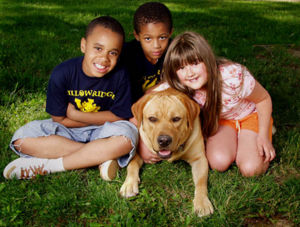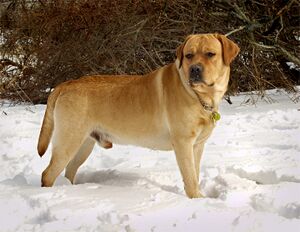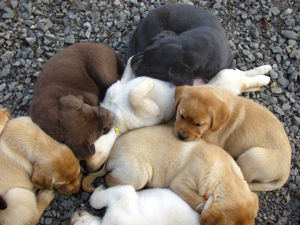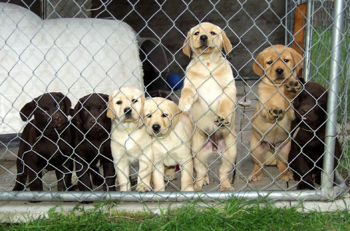Labrador Retriever: Difference between revisions
imported>Nancy Sculerati |
imported>Nancy Sculerati |
||
| Line 8: | Line 8: | ||
[[Image:Lab_hunting_test.jpg|left|thumb|250px|Labrador retriever returns with her quarry at at a hunting test. Photo by Andrew A. Skolnick]] | [[Image:Lab_hunting_test.jpg|left|thumb|250px|Labrador retriever returns with her quarry at at a hunting test. Photo by Andrew A. Skolnick]] | ||
== | ==Breed standards== | ||
===Overview of appearance=== | ===Overview of appearance=== | ||
Revision as of 11:22, 3 April 2007
The Labrador retriever is the most popular registered breed of dog in both the United Kingdom and the United States, two of the most "dog-friendly" cultures in the world. What about this breed is likely to account for such outstanding popularity? Labradors are generally both exceptionally friendly, and eager to please, making them excellent companions for children, as well as adults. Their intelligence and size also makes them suitable service animals.
Having been bred first to help Newfoundland fishermen haul in their fishing nets and then in Great Britain as 'gun dogs' for hunting waterfowl, Labs are powerful swimmers who love the water. As much as most Labs take to swimming, life on dry land also suits them - as long as there is an opportunity for some exercise. Their ability to adapt to both city and country life is one more factor that accounts for their popularity (ref:SPORTING GROUP: Labrador RetrieversFaith Hyndman. AKC Gazette. New York: Jul 2006. Vol. 123, Iss. 7; p. 51)
History
It is thought to have descended over time from the St. John's Water Dog (no longer in existence), a crossbreed of native water dogs and the Newfoundland dog (to which the Labrador is closely related), through ad-hoc breedings by early settlers in the 17th century.[1]
Breed standards
Overview of appearance
Labradors are moderately large dogs with males typically weighing 27 to 36 kg (60 to 80 lb) and females 23 to 32 kg (45 to 70 lb). Dogs bred for the show ring tend to be considerably heavier.
Their coats are short and smooth, and they possess a thick, powerful tail that superficially resembles the tail of an otter. The "otter tail" of the Lab is used in swimming and is a characteristic that is specifically selected for in breeding. Other characteristics that are helpful for water retrieving are the dog's water resistant coat and webbed toes.
As with some other breeds, the British ("show") and the American ("working" or "field") lines differ. Labs are bred in Great Britain, shorter and stockier with broader faces and a slightly calmer nature than their American counterparts, which are bred taller, lighter, and more energetic. No distinction is made by the AKC, but the two classifications come from different breeding. Australian stock also exists; though not seen in the west, they are common in Asia. (See #Physical lines and variants) The breed tends to shed hair throughout the year. Lab hair is usually fairly short and straight, and the tail quite broad and strong.
The otter-like tail and webbed toes of the Labrador retriever make them excellent swimmers. Their interwoven coat is also relatively waterproof, providing more assistance for swimming. The dogs use their tail as rudders to help them steer while swimming. Their short hair allows them to work in icy waters, where longer-hair retrievers would be dragged down by ice clinging to their coats.
Color
There are three officially recognised Lab colors:[2] black (a solid black color), yellow (anything from light cream to gold to fox-red), and chocolate (medium to dark brown). Puppies of all colors may occur in the same litter. The nose of a black or yellow Lab should be black and a chocolate's should be brown, although some fading to pink is permitted. Pink noses without pigmentation is a disqualification. A color variation some call "silver" may involve unusually light-colored chocolates or may be the result of cross breeding with Weinmaraners. The variation is not recognized by any breed or kennel club and is not permitted in confirmation shows.
Variant lines
Differences in the physical build of the dog have arisen as a result of specialized breeding. Dogs bred for hunting and field-trial work are selected first for working ability, whereas dogs bred to compete for show championships are selected for the characteristics that judges favor in the show ring.
There are significant differences between the American field and British show lines. In general, show-bred Labs are heavier, shorter-bodied, with thicker coat and tail. Field Labs are generally longer legged, lighter, and more lithe. In the head, show labs generally have broader heads, better defined stops, and thicker, more powerful necks, while field Labs have somewhat narrower heads with longer muzzles.[3] [4] [5] Field-bred Labs are commonly more energetic and high-strung compared with show-bred Labs. As as a consequence, they may be better suited to working relationships than being just a family pet. [3] [4] [5] Of course, each individual dog differs. Some breeders, especially those specializing in the field type, feel that breed shows do not adequately recognize their type of dog. Talk of officially splitting the breed is also sometimes supported. [6]
Lab nose and skin pigmentation
Labrador Retriever. The nose and lips are pink or flesh-colored, the defining aspect of Dudley pigmentation, as compared to the more standard brown or black. Because Lab coloration is controlled by multiple genes, it is possible for recessive genes to emerge some generations later and also there can sometimes be unexpected pigmentation effects to different parts of the body. Pigmentation effects appear in regard to yellow labs, and sometimes chocolate, and hence the majority of this section covers pigmentation within the yellow Lab. The most common places where pigmentation is visible are the nose, lips, gums, feet, and the rims of the eyes, which may be black, brown, light yellow-brown ("liver", caused by having two genes for chocolate),[7] or several other colors. A Lab can carry genes for a different color, for example a black Lab can carry recessive chocolate and yellow genes, and a yellow Lab can carry recessive genes for the other two colors. DNA testing can reveal some aspects of these.
Less common pigmentations (other than pink) are a fault, not a disqualification, and hence such dogs are still permitted to be shown.[7]
The intensity of black pigment on yellow Labs is controlled be a separate gene independent of the fur coloring.[7] Yellow Labs usually have black noses, which gradually turn pink with age (called "snow nose" or "winter nose"). This is due to a reduction in the enzyme tyrosinase which indirectly controls the production of melanin, a dark coloring. Tyrosinase is temperature dependent - hence light coloration can be seasonal, due to cold weather - and is less produced with increasing age (2 years old onwards). As a result, the nose color of most yellow Labs becomes a somewhat pink shade as they grow older.[8] [7]
"Dudley"
A coloration known as "Dudley" is also possible. Dudleys are variously defined as yellow Labs which are unpigmented (pink) (LRC), yellow with liver pigmentation, or "flesh colored" (AKC), rather than having black or brown pigmentation.[7] A yellow Lab with brown or chocolate pigmentation (for example, a brown/chocolate nose), is not a Dudley. Breed standards for Labradors considers a true Dudley to be a disqualifying feature for a show Lab ("Disqualification: A thoroughly pink nose or one lacking in any pigment"). True Dudleys are extremely rare.[7] [9][10] (See: Albinoism). Breeding in order to correct pigmentation often lacks dependability. Because color is determined by many genes, some of which are recessive, crossbreeding a pigmentationally non-standard yellow Lab to a black Lab may not correct the problem or prevent future generations carrying the same recessive genes. That said, pigmentation is often not an issue with animal lovers for whom such issues are often unimportant, and only has significance for those involved with showing and breeding.
Temperament and activities
Labradors are a well-balanced and remarkably versatile breed, adaptable to a wide range of functions as well as making very good pets. As a rule they are not excessively prone to territorialism, pining, insecurity, aggression, destructiveness, hypersensitivity, or other difficult traits which manifest in a variety of breeds, and as the name suggests, they are excellent retrievers. As an extension of this, they instinctively enjoy holding objects and even hands or arms in their mouths, which they can do with great gentleness. They are also known to have a very soft 'feel' to the mouth, as a result of being bred to retrieve game such as waterfowl. They are prone to chewing just about everything, although they can be trained to restrict their chewing to their toys.
Labradors have a reputation as a very mellow breed and an excellent family dog (including a good reputation with all ages of children). However, their fun-loving boisterousness and lack of fear can result in mischief and may require training and firm handling at times to ensure that it does not get out of hand. Labradors mature at around three years of age. Immature Labs have bounding amounts of puppyish energy, which is often mislabelled as being [hyperactivity|hyperactive]]. [11] Labs often enjoy retrieving a ball endlessly and other forms of activity (such as dog agility or flyball). They are considerably "food and fun" oriented, very trainable, open-minded to new things, and thrive on human attention and interaction, of which they find it difficult to get enough. Reflecting their retrieving bloodlines, almost every Lab loves playing in water or swimming.
Although they will sometimes bark warning over unusual noises or events, on the whole Labs are fairly quiet dogs.[12] They are not overly territorial and are often very easygoing and trusting with strangers. They therefore usually are not used as guard dogs. [13]
Labradors are known for their appetite, and individuals have been described as willing to eat "anything that isn't nailed down".[14] They are also persuasive and persistent in requesting food. For this reason, the Lab owner must carefully control his/her dog's food intake to avoid obesity and its associated health problems (see below). The steady temperament of Labs and their ability to learn make them an ideal breed for search and rescue, detection, and therapy work. Their primary working role continues to be that of a hunting retriever.
Health and wellbeing
Labrador life expectancy is generally 12 to 13 years[15], and it generally is a healthy breed with relatively few major problems. Notable issues related to health and wellbeing include:
Medical conditions:
- Labs are somewhat prone to hip dysplasia (and possibly other forms, such as elbow dysplasia), especially the larger dogs, though not as much as some other breeds. Hip scores are recommended before breeding.
- Labs are sometimes prone to ear infection, because their floppy ears trap warm moist air. This is easy to control, but needs regular checking to ensure that a problem is not building up unseen. A healthy Lab ear should look clean and light pink (almost white) inside. Darker pink (or inflamed red), or brownish deposits, are a symptom of ear infection. The usual treatment is regular cleaning daily or twice daily (being careful not to force dirt into the sensitive inner ear) and sometimes medication (ear drops) for major cases. As a preventative measure, some owners clip the hair carefully around the ear and under the flap, to encourage better air flow.
- The prevalence of a birth defect called tricuspid valve dysplasia (TVD) appears to be on the rise in Labs. Puppies with the inherited condition have a mishapen tricuspid heart valve that prevents it from closing tightly. As a result, blood regurgitates back through the valve producing an abnormal heart sound called a murmur. The size of the leak determines the severity of the disease. Most puppies with mild regurgitation can have a normal life, but those with severe leakage may not reach their first birthday. TVD usually can be detected by listening to the puppy's heart with a stethoscope. However, a cardiac ultrasound exam may be needed to detect the mildest cases. [16]
- Labs also suffer from the risk of knee problems. A luxating patella is a common occurrence in the knee where the leg is often bow shaped.
- Eye problems are also possible in Labs, particularly progressive retinal atrophy and retinal dysplasia. Dogs which are intended to be bred should be examined by a veterinary ophthalmologist. [17]
Weight:
- Labs are often overfed and are allowed to become overweight, due to their blatant enjoyment of treats, hearty appetites, and endearing behavior towards people. A healthy Lab should keep a very slight hourglass waist and be fit and lithe, rather than fat or heavy-set. Excessive weight is strongly implicated as a risk factor in the later development of hip dysplasia and diabetes, and also can contribute to general reduced health when older. Arthritis is common in older Labs, especially those that are overweight.
Exploration:
- Labradors are not especially renowned for escapology. They do not particularly jump high fences or dig, although some Labs may climb or jump up for fun or to explore. As a breed they are highly intelligent, and capable of intense single-mindedness and focus if their interest is caught. Therefore with the right conditions and stimuli, a bored Lab could "turn into an escape artist par exellence." [2]
- It is important to remember that Labradors are curious, relatively without fear, and love company. They may take off to follow strangers or other dogs, or most anything else that is novel or gives off an interesting scent. Owners are therefore advised to have their Labradors microchipped in addition to having them wear a collar and tag with the owner's contact information.
References
- ↑ http://www.heritage.nf.ca/society/settlement.html
- ↑ The American Kennel Club, Labrador Retriever Breed Standard: "The Labrador Retriever coat colors are black, yellow and chocolate. Any other color or a combination of colors is a disqualification. A small white spot on the chest, called a star, is permissible, but not desirable. White hairs from aging or scarring are not to be misinterpreted as brindling. Black:-Blacks are all black. A black with brindle markings or a black with tan markings is a disqualification. Yellow:-Yellows may range in color from fox-red to light cream, with variations in shading on the ears, back, and underparts of the dog. Chocolate:-Chocolates can vary in shade from light to dark chocolate. Chocolate with brindle or tan markings is a disqualification."
- ↑ 3.0 3.1 http://www.labbies.com/history.htm History of the Labrador Retriever. Retrieved on February 5, 2007.
- ↑ 4.0 4.1 http://www.pineycreeklabradors.com/id20.html
- ↑ 5.0 5.1 http://www.woodhavenlabs.com/english-american.html
- ↑ http://www.woodhavenlabs.com/documents/breed_split2.pdf
- ↑ 7.0 7.1 7.2 7.3 7.4 7.5 http://www.woodhavenlabs.com/yellow-pigment.html
- ↑ See this post on justlabradors.com forum, posted July 2006 by WigWag [presumably Sharon Wagner of wigwaglabradors.com, cited elsewhere in this article concerning Labrador coloration]
- ↑ Labrador Retriever Breed Standards Comparison Chart
- ↑ Dog Breed Advice on Dudley Labradors
- ↑ http://www.dogbreedadvice.com/Labrador-FAQ : "Labradors are active dogs especially in puppyhood. And Labradors often do not fully mature until around 3 years of age! This means you will have a dog that is mentally a puppy (with a puppy's energy) until this age regardless of its physical size! Often a Lab puppy is labelled hyperactive when it is simply a normal, exuberant and bouncy puppy. If you are prepared to deal with this period of time in their lives, you will not have problems."
- ↑ http://www.dogbreedadvice.com/Labrador-FAQ : "excessive barking is not generally typical of the breed. Labradors often give a warning bark in response to an unusual event..."
- ↑ http://www.dogbreedadvice.com/Labrador-FAQ : "Labradors are not reliable guards. Some can be protective and most will probably bark if they hear or see something they don't like -- particularly if it is near their yard. If your main purpose in getting a dog is to have a guard dog, a Labrador is not a good choice, but if you want an "alarm" barker, most Labradors are fine."
- ↑ Marley and Me forum thread (a well-known biography about a beloved Labrador), multiple contributors: "My 12 yr old Lab in the course of his life has consumed everything and anything" ... "my Lab went through a phase of rock chewing when he was much younger" ... "His current fav is Playdoe dropped by any little girl. To be honest I cant think of much he hasn't eaten" ... "I have 3 Labs at home. A black Lab 11yrs, a yellow thats 2 1/2 and another yellow that is 14 months. And I think I have seen them eat just about anything that is not nailed down or behind closed doors" [1]
- ↑ Fogle, Bruce, DVM (2000). The New Encyclopedia of the Dog. Dorling Kindersley. ISBN 0-7894-6130-7.
- ↑ http://www.gglrc.org/articles/tvd.shtml
- ↑ http://www.dogbreedadvice.com/Labrador -FAQ
Further reading
- Cunliffe, Juliette (2004). The Encyclopedia of Dog Breeds. Parragon Publishing. ISBN 0-7525-8276-3.
- Fergus, Charles (2002). Gun Dog Breeds, a Guide to Spaniels, Retrievers, and Pointing Dogs. Guilford, CT: Lyons Press. ISBN 1-58574-618-5.






